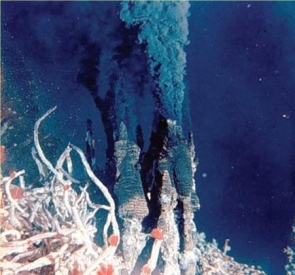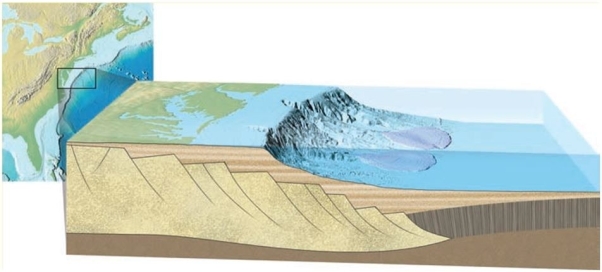A) the Indian Ocean
B) the Atlantic Ocean
C) the Pacific Ocean
D) all three of these oceans
Correct Answer

verified
Correct Answer
verified
Multiple Choice
Which one of the following statements about mid- ocean ridges is false?
A) They are sites for submarine eruptions of basaltic lava.
B) Sediments include thick siliceous ooze deposits and sandy turbidite beds.
C) They are where young lithosphere is added to the edges of spreading, oceanic plates.
D) Terrigenous sediment coverings are very thin or absent.
Correct Answer

verified
Correct Answer
verified
Multiple Choice
Give the correct type of ocean floor sediment for each phrase. -Abyssal plain clay
A) biogenous
B) hydrogenous
C) terrigenous
D) phytogenuous
Correct Answer

verified
Correct Answer
verified
Multiple Choice
The continental rise lies_______ the continental slope.
A) within
B) just above
C) nowhere near
D) just below
Correct Answer

verified
D
Correct Answer
verified
Multiple Choice
It is thought that submarine canyons on the continental slope have been generated by______ .
A) streams when sea level was much lower than it is today
B) streams when sea level was much higher than it is today
C) turbidity currents
D) a submarine glaciations
Correct Answer

verified
Correct Answer
verified
Multiple Choice
What is the difference between an active continental margin and a passive continental margin?
A) An active margin receives large amounts of sediment whereas a passive margin is sediment starved.
B) A passive margin is the site of an ancient continental rift, left behind when seafloor spreading moved offshore, whereas an active margin is an active plate boundary.
C) An active margin has earthquakes whereas a passive margin has quiet erupting aka passive. volcanoes.
D) A passive margin is passively carried along by plate tectonics in a transform system, like the San Andreas whereas an active margin is a trench.
Correct Answer

verified
Correct Answer
verified
Multiple Choice
Minerals that crystallize directly from seawater are examples of______ .
A) terrigenous sediment
B) biogenous sediment
C) hydrogenous sediment
D) both terrigenous and biogenous sediment
Correct Answer

verified
Correct Answer
verified
Multiple Choice
Most of our table salt comes from______ .
A) combining the metal sodium and the nonmetal chlorine gas in a chemical reaction vessel to make pure NaCl
B) China
C) salt obtained by evaporating seawater in dry climates
D) salt taken from mines
Correct Answer

verified
Correct Answer
verified
Multiple Choice
Which one of the following would most likely be covered with thick turbidite layers?
A) upper part of a steep, narrow, submarine canyon
B) ocean floor around a conical- shaped seamount
C) deep- sea fan at the base of a continental slope
D) axial rift zone of an active mid- ocean spreading center
Correct Answer

verified
Correct Answer
verified
Multiple Choice
Examine the words and/or phrases below and determine the relationship among the majority of words/phrases. Choose the option that does not fit the pattern.
A) continental slope
B) continental volcanic arc
C) continental shelf
D) continental rise
Correct Answer

verified
Correct Answer
verified
Multiple Choice
An echo sounder operates by measuring the time required for a______ .
A) sound pulse travels from a ship to the seafloor and back
B) radar beam to travel from a ship to the seafloor and back
C) light beam to travel from a satellite at a known altitude to the sea bottom and back
D) radar beam to travel from a harbor patrol boat to a fuzz- buster on a speeding yacht
Correct Answer

verified
Correct Answer
verified
Multiple Choice
How do atolls form?
A) from turbidity currents
B) from fringing coral reefs around a volcano
C) sediment traps in trenches
D) from black smokers that build up excess minerals
Correct Answer

verified
Correct Answer
verified
Multiple Choice
If Yellowstone were on the ocean floor, it would produce ______.
A) a mid- ocean ridge
B) an island arc
C) a chain of line islands, like Hawaii
D) a trench
Correct Answer

verified
Correct Answer
verified
Multiple Choice
Sediments derived primarily from the products of weathering on the continents are called
A) terrigenous sediment
B) biogenous sediment
C) hydrogenous sediment
D) both terrigenous and biogenous sediment
Correct Answer

verified
Correct Answer
verified
Multiple Choice
The 2010 Deepwater Horizon oil spill in the Gulf of Mexico was the largest environmental disaster in North American history. It was brought on in part by new technology allowing development of oil and gas reserves in deep water. Given the scope of the spill, why do companies take a risk of such a disaster given the scope of the litigation following the disaster?
A) The oil and gas industry is poor at assessing risk, and didn't understand the risk.
B) They just assume their lawyers can win any lawsuit, regardless of the disaster.
C) The potential profit is so large from a major oil find that the companies take the risk, try to use all cautions to minimize risk, but sometimes fail.
D) They didn't care about the risk, they just drove forward.
Correct Answer

verified
Correct Answer
verified
Multiple Choice
Identify what is pictured here: 
A) rift valleys
B) hydrogenous flow structures
C) black smokers
D) guyots
Correct Answer

verified
Correct Answer
verified
Multiple Choice
_______ continental margins typically exhibit wide, extensive, continental shelves.
A) Turbidity
B) Passive
C) Active
D) Deep sea
Correct Answer

verified
Correct Answer
verified
Multiple Choice
_______ form the deepest parts of the ocean basins.
A) Trenches
B) Submarine canyons
C) Continental shelves
D) Continental slopes
Correct Answer

verified
A
Correct Answer
verified
Multiple Choice
Where are the deepest parts of the oceans?
A) along the base of the continental slope
B) in the abyssal plain
C) in rift valleys at sea floor spreading center
D) in trenches
Correct Answer

verified
Correct Answer
verified
Multiple Choice
Consider the diagram below.  What type of margin is this?
What type of margin is this?
A) Passive, because the deep sea fans indicate tectonic activity.
B) Passive, because the lack of trenches and subducting oceanic crust indicate tectonic activity.
C) Active, because the deep sea fans indicate tectonic activity.
D) Active, because the lack of trenches and subducting oceanic crust indicate tectonic activity.
Correct Answer

verified
B
Correct Answer
verified
Showing 1 - 20 of 92
Related Exams